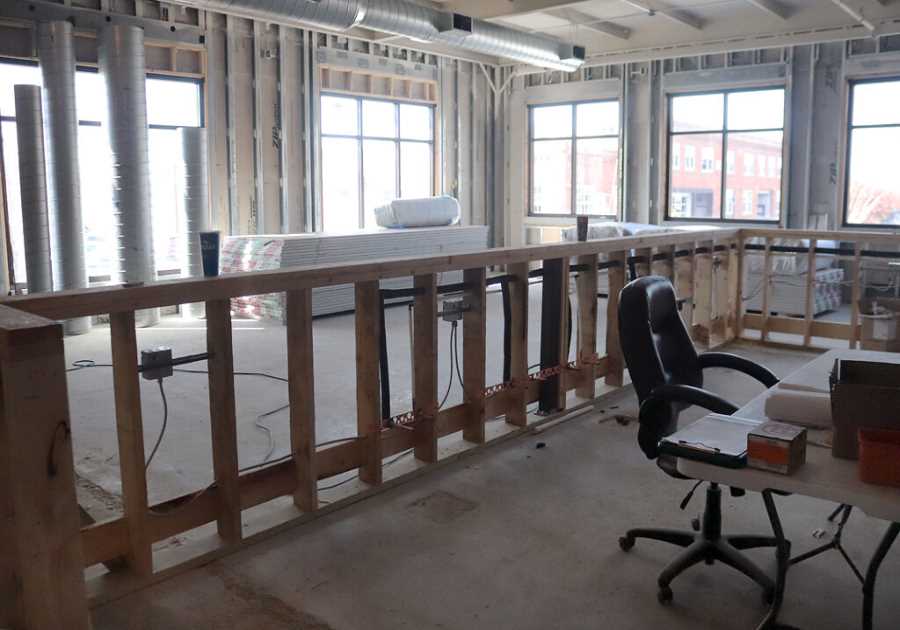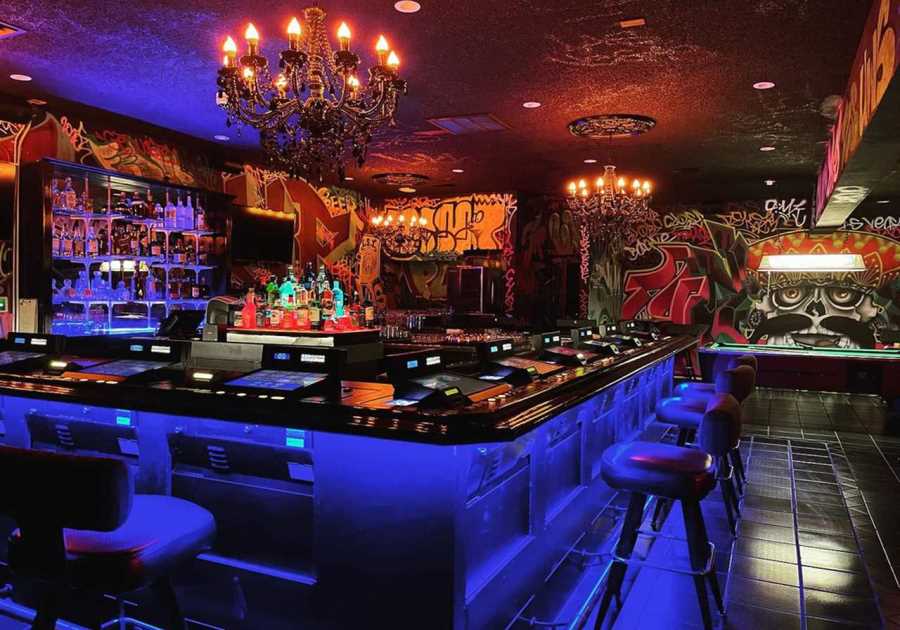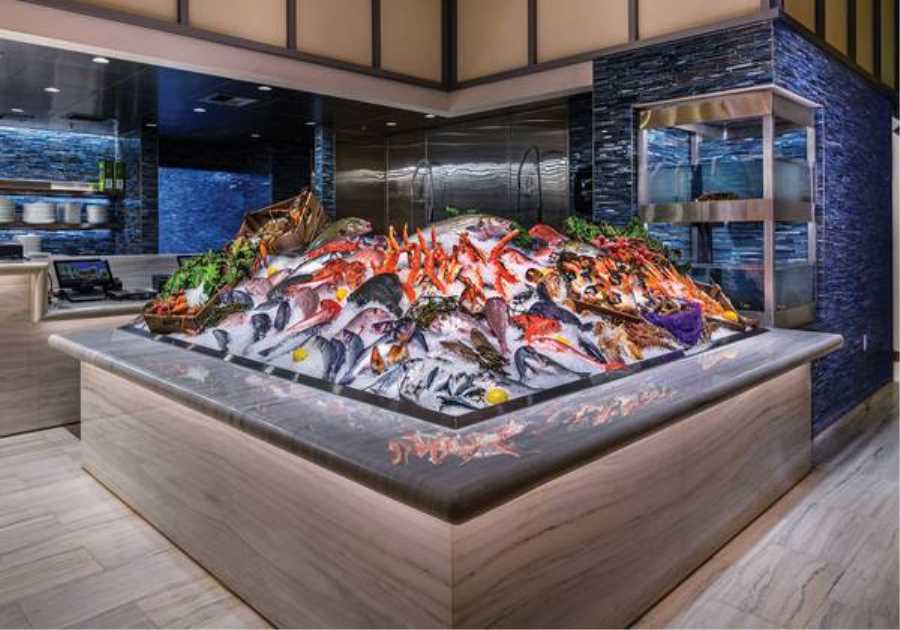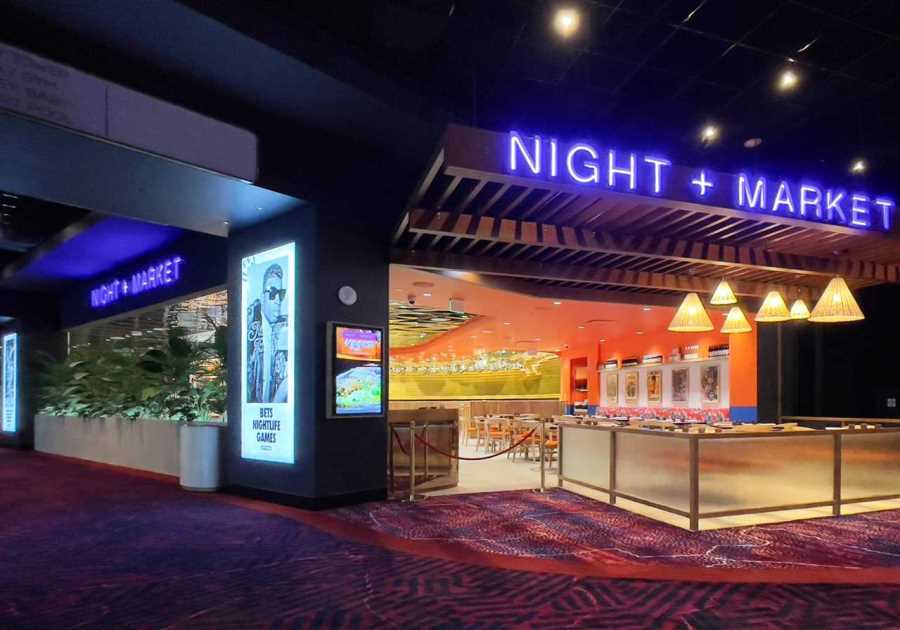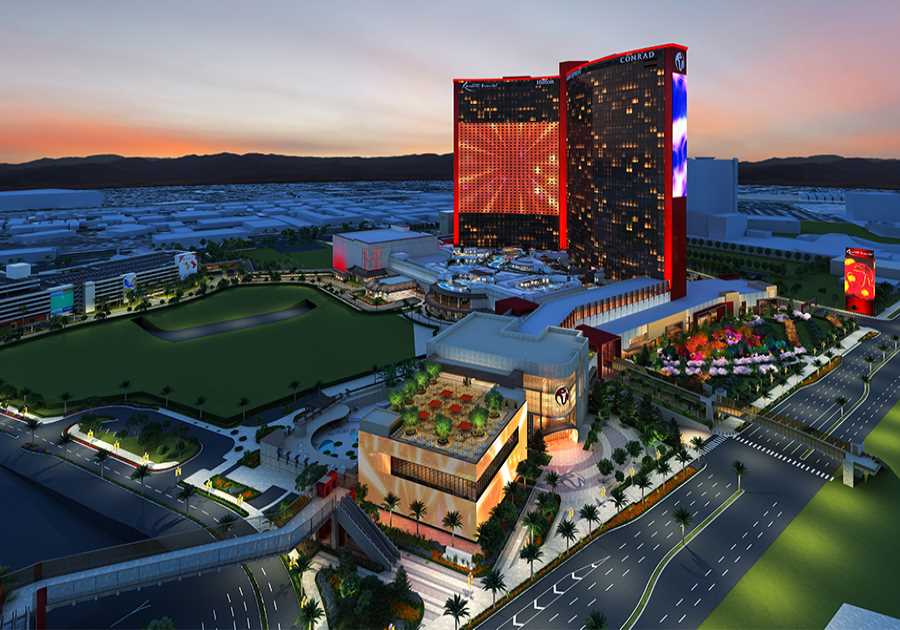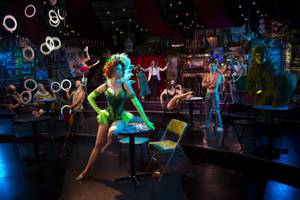
It began as a curiosity before blossoming into an unlikely hit on the Las Vegas Strip, something that simultaneously mocked and celebrated its own influences and inspirations. Then at some point, Absinthe became that one thing that everyone needed to check out when in Vegas, even for those of us who are always in Vegas.
Now at 10 years old, it’s a full-fledged institution, still one of the most buzzed-about shows on the Strip (even through the pandemic year) and a landmark innovation that has impacted the direction of live entertainment in Las Vegas.
Photo: Spiegelworld Photo: Courtesy Absinthe
Edgy, alluring, outrageous, jubilant—you know what Absinthe is. But it was supposed to be something different upon landing on the Strip. Although the earliest shows and foundations of its creative company, Spiegelworld, were built in New York City in 2006, the original plan for a Vegas invasion was hatched a few years later in Miami.
Founder Ross Mollison says the company was built around the notion of multiple experiences occurring in or around a spiegeltent, a large structure typically made of canvas and wood and decorated with mirrors and stained glass—a makeshift entertainment venue that can be set up and broken down in order to travel from city to city.
“If you look at the early pictures from New York where we first put it up on Pier 17 under the Brooklyn Bridge, there was a beer garden where you could sit and have a drink in this beautiful location; there were multiple artists and musicians through the day and night; we had a nightclub that would go on later with a restaurant next to it and a speakeasy cocktail bar hidden in a shipping container—and Absinthe was sort of the anchor production of all of it,” Mollison says.
The varied programming and ideal location generated rave reviews and sold-out shows, and Absinthe’s initial success powered the rest of the experience. Touring it around the world was already the next step in the master plan, hitting four cities a year for three months per engagement.
In Miami, Absinthe set up its tent on the beach near the W Hotel and managed to avoid disaster despite sluggish initial ticket sales and late approval from the fire marshal. Mollison met lots of interesting characters there, some of whom may or may not have been the dealmakers they claimed to be. But some guy named Jeff, who said he was building a slew of hotels, including one in Vegas, fell in love with the show and wanted to bring it to the Strip. He turned out to be Jeffrey Soffer, CEO of Fontainebleau Development, and he signed Absinthe up to be the opening resident show at the towering blue 3,780-room Fontainebleau Las Vegas.
The resort famously never opened after the recession pitted its finances in 2009. (The property has changed hands and been replanned a few times, including earlier this year, when Fontainebleau reacquired the land in partnership with Koch Industries.)
The recession almost killed Spiegelworld, too. When his big Vegas deal disappeared, Mollison says it was the start of a very dark period in which the company was essentially reduced to one employee fighting to resurrect that which a creative cast and crew had spent years building.
“I put together this incredible presentation to pitch to all the resorts, and we ended up with a meeting with Gary Selesner at Caesars,” Mollison says. “We pitched a lot of people over the years in Las Vegas, and fortunately when we pitched Caesars, there was [Selesner] who grew up in New Jersey, understanding New York, and he got what we were talking about.”
Selesner, now president at Caesars Entertainment, gave the show a shot with a six-month deal to set up on the underutilized concrete patch on the southeast corner of the Caesars Palace site, steps away from Las Vegas Boulevard. Mollison recalls the final pitch meeting where the deal got the greenlight from casino execs as a desperate moment for the show and his company.
“I remember thinking, this is everything, this is my future, and if we didn’t get it, it would be back to the drawing board. It could be years before I’d get another opportunity like this,” he says. “The person in charge of marketing was saying, ‘I hate it. I don’t think it’s on brand. We’re a five-star resort, and this doesn’t sound like a five-star experience. But this is exactly where I was sitting when we said no to Cirque du Soleil, so my vote is we give it a go.’”
The Gazillionaire at Caesars Palace
Absinthe opened on April Fool’s Day 2011 in an actual, temporary Spiegeltent at the heart of the Las Vegas Strip. While the international cast of comedians, acrobats, dancers and specialty performers had already honed the cabaret-meets-circus presentation, the unique venue added some challenging wrinkles to the show’s future in Vegas.
“Spiegeltents are beautiful venues that have a lot of charm to them, but a mostly wooden structure in the desert wasn’t going to be a long-term play,” says Jennie Connery, Spiegelworld’s chief operating officer who joined the company in 2010. “When we put up the tent we have now, it was a whole different process of creating an interior space to maximize the world of a Spiegeltent but take it to another level.”
The current tent, installed in the fall of 2011, is actually a permanent structure with a façade that maintains the look and feel of the world of Absinthe. After its initial run, producing partner Base Entertainment wanted to take the show inside a casino, but Mollison preferred to continue to grow at the original Caesars space. The two companies would dissolve their partnership in 2017.
*****
Absinthe was a blast of fresh air for the Strip, but the timing of its arrival was key to its early success, because the sagging economy meant there were few new Vegas shows and experiences at the time. And the company quickly realized it could create momentum by appealing to Las Vegas residents, actively marketing against the old adage that locals don’t spend time and money on the Strip.
“We knew this needed to be here more than the six-month run. The trajectory was there,” Connery says. “Early on, we were embraced by the local community. We became that show that had good word-of-mouth—residents would recommend it to their friends who were visiting from out of town, that this was the one show we would take you to see while you’re here.”
In the tent and on the stage, Absinthe packed its shows with talented variety acts from all over the world, a rapid-fire approach guided by now-familiar characters like the Gazillionaire, the Green Fairy and co-host Penny Pibbets (or Wanda Widdles). The comedy was racy and fueled that word-of-mouth factor, while the daring acrobatics felt even more suspenseful due to the venue’s intimacy.
A perfect example is the unforgettable roller-skating-in-the-round act performed by sibling duo Billy and Emily England. “During one of the first dress rehearsals … going into the launch of the show in 2011, there was someone who had never seen many of the acts and hadn’t been part of the rehearsal process until this day, and they turned to me in utter shock during that one,” Connery says. “They just couldn’t believe it, asking, ‘Are the skaters really supposed to go that fast?’”
Another early act that maximized the intensity was the Esteemed Gentlemen of the High Wire, a three-man performance that took place on a tightrope just a few feet above the stage. Their skill and the audience proximity made up for the fact that the wire wasn’t so high.
Photo: Photo Powers Imagery LLC Absinthe
“It’s amazing to be in such a small, intimate setting where any seat in the house can really see that muscle being flexed, see the performers flip and curl around that wire,” says Lijana Wallenda, who helped create that original act and now heads up costume design and aerial act training and safety for Absinthe.
She’s also a seventh-generation member of the famous Flying Wallendas family act and a fourth-generation high-wire walker who spent her whole life traveling the world and performing at different circus, fair and amusement park events before settling in Las Vegas with Absinthe.
Wallenda is known for performing with her brother Nik for daredevil walks including one 25 stories across Times Square in 2019, her comeback after being seriously injured during a rehearsal two years earlier. When she launched Absinthe, it was the first time she had developed a wire act without performing in it.
“When I came out to coach, I was seven months pregnant, and it was a six-month contract,” Wallenda says. “It’s crazy to think it’s been 10 years, and how this show changed my life. I’d never been so still in one city for so long after being a traveling performer my whole life. It’s been an amazing experience and so rewarding in so many ways.”
Known onstage as Duo Vector, Polish acrobats Michal “Misha” Furmanczyk and Lukasz Szczerba are original cast members who also leapt at the chance to perform in Las Vegas with no inkling they would end up calling this strange city home for so long. They’d competed separately in acrobatic competitions in their home country before joining forces to create a unique act in 2008.
“I always wanted to have an act where both partners are physically similar,” Szczerba says. Hand-balancing duos like this one are usually made up of a larger athlete—the base—and a smaller person who serves as the flyer. “People often ask if we are brothers, so this approach seems to be working.”
Duo Vector joined Absinthe after Mollison saw the pair perform in Munich in the fall of 2010. He describes traveling the world and discovering new talent as a favorite part of the process, and it has become even more enjoyable as Spiegelworld has grown and become a sought-after employer in the entertainment industry.
“I wouldn’t say we’ve gone global the way a show like [Cirque du Soleil’s] O is global, but certainly, we are a global brand with artists,” Mollison says. “When I first came to Vegas, artists from Germany might say, ‘Oh, you’re the guy that went bankrupt in 2008 after that show on the pier.’ We’ve been able to reposition ourselves as a big success in Las Vegas.”
Because Absinthe is always on the hunt for new acts and artists, and keeping the show fresh means keeping new and old customers coming back for more, all that travel and recruitment and brand-building directly impacts what happens onstage.
Photo: Powers Imagery, Brenton Ho Photo: Courtesy Absinthe’s Wande Widdles
“It’s a marriage of both seeking out [acts] and developing them,” Mollison says. “It’s going to Berlin and seeing someone and then going to dinner and offering them a job, and then the artist gets to Vegas and you have to figure out how to make it Vegas appropriate. Then there are acts like the sway poles, which has been a dream of mine for a long time to have this show within a show, and that one we totally created; it didn’t exist anywhere.”
Since they’ve been in the show the whole time, the Duo Vector guys have seen the cast evolve and understand better than most how all its pieces fit together.
“I think every act has some function in the show. Some have to be showstoppers, some have to be romantic, others have to be technical, but all the ones we have now and used to have fit perfectly,” Szczerba says. “They have a specific role, and every time I see the show, I can’t believe how good it is and how the choreography and comedy all works together.”
Furmanczyk calls performing in Las Vegas a dream, something that sounded too good to be true. After living that dream for a decade, he still marvels at his colleagues’ talents, explaining that he’s still stunned by the roller-skating act, for example, every time he sees it.
“I think Ross’ idea is to bring the most unique acts, something you won’t see anywhere else, so when you come to the show, you’ll always be surprised,” Furmanczyk says. “It’s been uplifting for me, seeing the show grow so much, and now it’s so well-established in this city. To be a part of it is something we are proud of, and to see it from the inside feels really good.”
*****
Returning to the Spiegeltent at Caesars Palace after the pandemic shut down the Strip for months also felt really good for the entire Absinthe team, but that comeback wasn’t continuous. Absinthe was one of the first major shows to bring back live performances, on October 28, reconfiguring its in-the-round venue with distanced cabaret tables for audiences of approximately 150 people in a space built for 660.
Then COVID-19 numbers spiked in Southern Nevada heading into the holidays, and the state added new safety restrictions, limiting Vegas showrooms to a maximum capacity of just 50 people. Absinthe continued, hoping it would just be a few weeks, but it was a few months before restrictions loosened. The show closed for a second time in mid-December, before reopening again on March 17.
Spiegelworld has maintained its prominent voice in the Vegas entertainment industry throughout the pandemic, introducing above-and-beyond safety protocols and other innovations to improve the experience and convenience for cast, crew and audience members while the show was being staged, and working to stay in touch with officials and lobby for reasonable restrictions behind the scenes. (Sometimes that effort has been public in the form of some comedic jabs on the YouTube series Vegashitshow, which launched last year.)
Mollison and his team aren’t the only Vegas producers pushing for more communication and discussion about keeping entertainment alive during the pandemic, but Absinthe has emerged as a leader in that regard.
“It was just pure terror, the terror of losing everything we worked so hard for,” Mollison says. “I didn’t see a road to survival, because we had been through the financial crisis, which crushed us. We’d been through September 11 and survived that. We’d taken these blows and waited for things to slowly get better. But this was an unfolding disaster that just got worse and worse.
“If we took on a sense of leadership in our business, it was for survival, and out of that have come many friendships with people who are our competitors,” Mollison continues. “We never would have had conversations with David Copperfield about what are we going to do, or conversations with resorts where I don’t have shows about what they are doing. I think this has created a great sense of strength in the entertainment industry for all of us going forward.”
Time will tell, but it appears as if the Vegas shows that were able to operate under the pandemic’s extreme conditions—varied productions includingX Country and Tape Face at Harrah’s, Piff the Magic Dragon at Flamingo and Extravaganza at Bally’s—have similarly stepped into a leadership role, guiding the way for the Strip’s impending full-scale return, testing the waters and taking the risks.
The Gazillionaire at Caesars Palace
“We had to furlough the vast majority of our employees at the beginning, and we wanted to remain in regular touch with everybody,” Connery says. “Very early on, we realized we couldn’t come back without someone exclusively focused on COVID mitigation, so we have a chief mitigation officer whose sole focus is [those] guidelines and processes. Above all, it’s been really important for us to be and feel like a safe space.”
Absinthe has also developed a reputation through the years for throwing wild parties to celebrate its anniversary in Las Vegas. There was no big celebration on April 1 this year, but every night the show has been performed since its St. Patrick’s Day return has felt like a mini celebration, one mixed with increasing measures of relief and joy. For a group of people who live to entertain, reconnecting with their audience and a community that has celebrated them for a decade means everything.
“You have an idea of what Vegas is, and then when you actually get in and become part of this community, it’s just such a wonderful town and such a small place with great people,” Mollison says. “When you come as a guest, it’s this big, incredible thing, and it’s been an absolute privilege for us to survive for 10 years.
“You look back at the big ones, [shows] like Folies Bergère and Jubilee! and you wonder, is that our trajectory? We didn’t feel like it was, but now, to be talking about a 10th anniversary, is incredible and doubly sweet because of the issues we had to deal with this last year.”
The latest on ‘Absinthe’s zany sister shows Spiegelworld planted the seed for its current Las Vegas entertainment empire when it opened Absinthe at Caesars Palace 10 years ago. But each project that followed has been developed in its own way with its own team of creatives, building off the original brand while establishing a unique identity in every show.
“I think we always try to start fresh when creating each show and go into the process with a new team putting together a new show, but we’re also always learning from every show we’ve ever done,” says chief operating officer Jennie Connery, who was working in more traditional theater production in New York City when she joined the Spiegelworld team. “We love the intimacy at Absinthe and condensing the audience into a space that’s relatively small, and we’ve used that in other places as well. But it’s not so much a template, and we feel like all of our shows are always changing.”
Spiegelworld debuted the free-flowing Vegas Nocturne at the Cosmopolitan at the end of 2013 in conjunction with innovative supper club Rose. Rabbit. Lie., a combo that was ahead of its time, according to company founder Ross Mollison. “I think the price points and concepts were just too ambitious,” he says. “It was a very difficult set of circumstances … but it was also the most exciting thing I think we’ve built, very ambitious and fantastic.”
Nocturne closed in 2014 while RRL soldiered on with its supper club model until Cosmo announced its closure last month. Spiegelworld renovated the show space there and opened the riotous sci-fi comedy variety show Opium in 2018. That show’s comeback will now be held until the company and the resort have finished updating the restaurant space and readying a new food and beverage and entertainment concept.
“To have the chance to come back and reimagine how to do it and make it a more exciting experience, now with six or seven years under the belt of learning how to do that, it’s going to be really fun,” Mollison says. “And we are enormous fans of what they have achieved at the Cosmopolitan through the years by redoing the property and adding so many innovations.”
Spiegelworld is also set to reopen its newest Vegas product, Atomic Saloon Show, at the Grand Canal Shoppes at Venetian/Palazzo on May 5. Opened to rave reviews in the fall of 2019 in an immaculately redesigned former nightclub space, Atomic had December plans to move to the Palazzo Theater for socially distanced performances but officials opted to hold off when restrictions tightened. Now, it will be able to return to its natural home in mere weeks for an audience of 108 instead of the standard 250.

